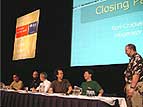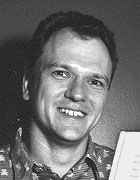| |
|
|
CONTACT JAOO
JAOO Conference
Scandinavian Center
Margrethepladsen 3
DK-8000 Aarhus C
Tel.:+45 87 32 87 87
Fax: +45 87 32 87 88
VAT: 25809149
jaoo@jaoo.dk
|

|
|
|
 |
|
Speaker
|
Frank
Buschmann
Siemens CT
Frank Buschmann is software engineer at Siemens Corporate Technology in Munich, Germany. His research interests include Object Technology, Application Frameworks and specifically Patterns. In his development work, Frank has lead the design and implementation of several large-scale industrial software projects, including business information, industrial automation, and telecommunication systems. Frank is co-author of "Pattern-Oriented Software Architecture -- A System of Patterns".
|

|
Presentation: "From Patterns to Pattern Languages"
Wednesday 10:00 - 10:45, Public Room
Patterns have taken the software community by storm.
Since the seminal work of the Gang-of-Four, patterns
found their way into many software development projects.
Yet, despite the countless success stories about patterns, it
appears that their influence on an entire software
architecture is still not as strong as it actually
could be: yet too many patterns are applied in isolation
to resolve local problems, with no or just limited
effect on a system's architecture. On the other hand,
it is widely known that a software architecture with
a high density of thoughtfully selected and tightly integrated
patterns can improve software quality significantly.
This talk introduces to the concept of pattern languages,
which reinforces the properties of individual
patterns at a higher, system-oriented level. In particular,
pattern languages aim at supporting the development
of specific types of system, system part, or system aspect
holistically with patterns: from their basic architecture,
over their detailed design, down to their implementation. Pattern
languages achieve this goal by weaving a set of related patterns
together in such a way that they define a generative process
for creating the types of system that they support.
The running example for this talk will be a pattern language
for distributed computing that integrates 90 patterns from the
Gang-of-Four, POSA, Kevlin Henney, Kent Beck, Doug Lea, Martin Fowler,
and many others, and also connects to seven well-known pattern languages.
From Patterns to Pattern Languages - (slides)
Please notice that the slides are password protected. You should have received an e-mail containing the required username and password.
|
Presentation: "Beyond the Gang of Four"
Tuesday 14:00 - 14:45, Tutorial Room
When software developers mention design patterns, the chances are that
they are talking about Design Patterns, the classic book by the Gang of
Four, rather than design patterns in general. Even when they are talking
about the pattern concept, as opposed to specific patterns, they often
think in terms of the form and idea presented in GoF, and rarely beyond.
However, the practice of software design is a far larger space than can
be covered by a modest vocabulary of 23 patterns. Nor is the pattern
concept that is useful in designing software identical with the GoF
view. Since the publication of the seminal work by GoF in 1994, a great
deal of research and practice in patterns has led to a better
understanding of both the pattern concept and the strengths and
weaknesses of the GoF patterns themselves.
This talk revisits the GoF patterns, reflects on them, deconstructs
them, and re-evaluates them from the practitioner's perspective: why
creational patterns such as Abstract Factory and Builder are missing a
vital ingredient to be proper parts of an architectural vocabulary; why
Singleton decreases a system's flexibility and testability; why Iterator
is not always the best solution for traversing aggregates; ...; and what you
can do about it.
Beyond the Gang of Four - (slides)
Please notice that the slides are password protected. You should have received an e-mail containing the required username and password.
|
|
Tutorial: "The secrets of quality software architectures"
Friday 13:00 - 16:00
Quality software systems require quality software architectures. Otherwise it is hard, if not impossible, to meet their functional and non-functional requirements or to master their inherent complexity. For instance, software architectures for systems with end-to-end quality of service demands, systems with stringent security requirements, or systems that are supposed to be in operation for 20+ years cannot be created on the fly, using contemporary middleware and tools. Instead these architectures must be crafted with care, following a defined specification process and being based on thoughtful design decisions.
This talk therefore explores some of the timeless secrets of building high-quality software architectures, in terms of process, methodology, design goals, and architectural properties, to bring the foundations of building successful software into everybodies mind.
Level:
Intermediate
Attendee background:
Development and design experience.
|
|
|
|
|

